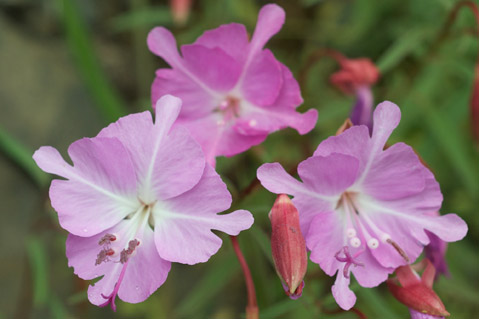Fairy Gardens
Flora Named After the Wee Creatures

Mainstream movies and television shows have probably changed the image conjured up by the word “fairy” for good. Once upon a time they were described as dwarf creatures wearing green clothes and having green hair (no Tinkerbell, that’s for sure) or diminutive beings that appear as a “beautiful, delicate, ageless, winged woman dressed in diaphanous white clothing” (a little closer to the Disney version). They were said to be benevolent at the least and sometimes even capable of projecting protective powers. Some believe that fairies are helpful to humans, while others insist that their assistance is mainly directed at plants.
Whatever the impetus, there are a number of plants that have garnered a name that suggests they might be suitable to lure these tiny creatures into the garden. To cool them through a hot spell, fairy fans (Clarkia breweri, a rare California native) not only ease their fever but make a fine show in a mixed border and do well as a cut flower, too (maybe the fairies will even follow them indoors). Foxglove is a handsome perennial plant with spires of drooping bell-shaped flowers in many shades of the floral rainbow. Should the fairies need a bell to celebrate their festivities, foxglove flowers, which are also known as fairy cap, fairy finger, fairy thimble, or fairy glove (apparently very friendly) are just the ticket.
There are at least two orchids that may be known by the name fairy-fringe, which sport a nice frilly fringe (nothing more feminine than a fringe, right?). The fairy slipper (Calypso bulbosa) is another orchid that, well, has a shape that could adorn a fairy foot. The flowers of fairy duster (Calliandra eriophylla and other species) are showy clusters of long, colorful stamens, and the shrubs have sturdy foliage that is finely divided. They must make fairy housekeeping a joy. To light the way for these ephemeral denizens, plant some fairy lanterns—species of the native California bulb Calochortus. These flowers, whose petals curve together to form a globe, hang down from graceful stems. Find a spot that can replicate their warm dry summer season or they will not thrive.
To perform their magic, apparently, fairies sometimes employ wands. Thus, the fairy wand (Dierama pendulum or D. pulcherrimum) may be a useful addition to the fairy garden. They are native to South Africa, so hopefully, local fairies will find them to their liking. These iris relatives have narrow grass-like leaves, but their arching flower stems introduce a graceful element to the perennial bed. Flowers come in shades of pink and white.
So, tongue-in-cheek notwithstanding, all of these plants can make delightful additions to the landscape. And who knows: Maybe fairies will also find their way into the gardens they grow in.
September Tips
• Keep camellias evenly moist, and boost blooms with low-nitrogen/high-phosphorus and -potassium formulations.
• Clean up any fallen fruit that can’t be salvaged. Left on the ground, it can contribute to fungal pathogens.
• Plant or transplant woody shrubs and trees. Their root systems will get established in the warm soil better and promote fast growth next season.
• Plant garlic. Buy “seed” garlic at nurseries or home improvement centers, or go online and find even more varieties. Bulbs will be ready to harvest in late spring next year.



